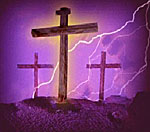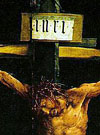Why do all four Gospels contain different versions of the inscription on the Cross?

Does the fact that all four Gospels contain different versions of the inscription on the Cross indicate error? By no means. Both Luke and John tell us that the inscription on the Cross of Jesus was written in three languages, Greek, Latin and Hebrew. It is therefore a reasonable assumption that three of the Gospel writers each chose to quote a different language, and that one writer chose to quote the words common to the other three.
Can this assumption be justified?
If so, can it be said with any certainty who chose to quote what?
And why?
THE INSCRIPTIONS
Let us begin with the way each writer prefaces the inscription(s).
Matthew 27:37 says, “And [they] set up over his head his accusation written.”
Mark 15:26 says, “And the superscription of his accusation was written over.”
Luke 23:38 says, “And a superscription also was written over him in letters of Greek, and Latin, and Hebrew.”
John 19:19 says, “And Pilate wrote a title, and put it on the cross.”
Notice that all these prefaces differ. Mark tells us that a superscription was written; Matthew, that it was set up over his head; Luke, that it was written in three languages; and John, that Pilate was the writer. All these statements are correct, even though each writer says something different!
The four accounts of the inscription are arranged below so the similarities and differences are easily discerned:
| Matthew 27:37 | THIS IS | JESUS | THE KING OF THE JEWS |
|---|---|---|---|
| Mark 15:26 | THE KING OF THE JEWS | ||
| Luke 23:38 | THIS IS | THE KING OF THE JEWS | |
| John 19:19 | JESUS OF NAZARETH | THE KING OF THE JEWS |
What was the significance of using three languages?
It was the custom of the Romans to use gypsum letters written on a rough board affixed to a cross to proclaim the reason why a person was being executed, although three languages were not always used.
Latin was the official language of the Roman Empire; it represented human government, power, and conquest. Greek was the international language of culture; it represented human wisdom, art, and commerce. Hebrew was the religious language of the Jews; it represented the Covenant Race, the Law of God, and the means by which God made Himself known to man. In the providence of God, all of these human and divine institutions were addressed when Jesus was crucified. How did this come about?
The most probable scenario is that the Roman governor, Pilate, dictated the title in Latin and the centurion in charge of the execution implemented the edict and its translation into the other languages. The words “King of the Jews” were a public sneer at the Jews by Pilate, and this was compounded by his additional taunt that their “king” came from Nazareth, i.e. that he was a despised Galilean.
JOHN
As John is the only Gospel writer who mentions Pilate, or Nazareth, or who calls the inscription a “title” (Latin: titulus), it is abundantly evident that John is quoting the Latin which read:

IESUS NAZARENVS REX IVDAEORVM
(Latin used “I” and “V” where English uses “J” and “U.”) That this is the Latin is further confirmed by the fact that the Early Church adopted as a symbol the Latin letters “INRI,” which are the first letters of this inscription (only), and this symbol appears in many early paintings of the crucifixion.
LUKE
Luke was a highly educated man (a physician—Colossians 4:14) and he addressed his Gospel to a Greek nobleman (the “most excellent Theophilus” of Luke 1:3). It is therefore very reasonable to suppose that Luke gives us the Greek inscription:
OUTOS ESTIN O BASILEUS TWN IOUDAIWN
MATTHEW
Matthew wrote for the Jews and used many quotations from the Old Testament to show that Jesus was the fulfillment of Old Testament prophecies concerning the Messiah. It is therefore most likely that Matthew quotes the Hebrew inscription (see drawing below).
MARK
This leaves Mark, whose Gospel is shorter than the other three, and who gives us a somewhat abbreviated account of the life of Jesus, as his purpose is to tell us more about what Jesus did than what Jesus said. For example, he omits the birth of Jesus, as well as the whole of the sermon on the mount and several other discourses. True to his style, Mark abbreviates the inscription to the words common to the three languages used, namely “THE KING OF THE JEWS.”
THE BOARD
Now comes the most interesting part! The Latin title, being the official indictment, would undoubtedly have been written first on the board. This then would have determined the length of the board and/or the size of the letters required to fit the inscription into one line and for it still to be readable by the crowd from a distance (John 19:20).
In those days they did not use spaces between the words in any of the languages as we do now, and so John's Latin “title” contained just 26 letters and no spaces.
Luke's Greek “superscription” contained 30 letters, and so must have been written in slightly smaller letters than was the Latin. It is easy to see that there would not have been room for 16 more letters for the words “Jesus of Nazareth” (i.e. “Jesus the Nazarene”) in Greek.
Matthew's “accusation” in Hebrew contained just 19 letters, which is rather fewer than the two other languages, because the Jews did not write vowels in Hebrew. Whoever translated the title into Hebrew apparently did not think it worth adding “of Nazareth.” Perhaps he thought that to have lived in Nazareth was not an indictable offense!
If we put all of this together, it is highly probable that the board with the inscriptions looked as shown below, with the Latin written first, probably at the top, and then either the Greek or the Hebrew.

Author: Russell M. Grigg. Supplied by Creation Ministries International. First published in Apologia 3(2):17-18, 1994


See ChristianAnswers’ large list of answers on other topics related to Jesus Christ’s life and death and resurrection
Endnotes
Although ancient Hebrew was dissimilar to the modern typewritten Hebrew script used here for convenience, the number of letters was the same.
The author wishes to thank linguist Dr. Charles Taylor, M.A., Ph.D., PGCE, LRAM, FIL, Cert Theol., for his kind advice and assistance.
Copyright © 1997, Creation Ministries International, All Rights Reserved—except as noted on attached “Usage and Copyright” page that grants ChristianAnswers.Net users generous rights for putting this page to work in their homes, personal witnessing, churches and schools.
